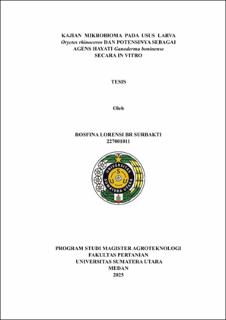Kajian Mikrobioma pada Usus Larva Oryctes Rhinoceros dan Potensinya sebagai Agens Hayati Ganoderma Boninense secara In-Vitro
Study of Microbiome in the Gut of Larvae Oryctes Rhinoceros and Its Potential as a Biological Agents of Ganoderma Boninense In-Vitro

Date
2025Author
Surbakti, Rosfina Lorensi Br
Advisor(s)
Bakti, Darma
Marheni
Metadata
Show full item recordAbstract
Palm oil (Elaeis guineensis Jacq.) is one of the important commodities in Indonesia. One of the plant pest organisms that inhibits the growth of oil palm productivity is the G. boninense pathogen and insect (O. rhinoceros). Insects have diverse and abundant microbes in their gut systems. Therefore, a comprehensive understanding of the function of gut bacteria in multispecies interactions may not only lead to the discovery new resources for biocontrol, but could also facilitate the development of new biopesticides. The larval stage of O. rhinoceros consumes empty oil palm fruit bunches to grow and develop into pupae. Various types of symbiont bacteria can be found in one type of animal. These bacteria are known to produce several hydrolase enzymes such as amylase, cellulase, protease, lipase and chitinase. This study aims to identify symbiotic bacteria from the intestines of O. rhinoceros larvae and determine their potential in inhibiting the growth of G. boninense, which causes stem rot disease in oil palm plants in vitro. This research was conducted at the Disease Laboratory, Faculty of Agriculture, University of Sumatera Utara, PT. Genetics Science Indonesia, Tangerang between April – September 2024. The methods used include morphological identification of the isolate, and physiological, biochemical, and molecular identification of the bacteria using 16s rRna gene sequencing and PCR (Polymerase Chain Reaction), as well as antagonist tests and hydrolysis tests for chitinase, protease and cellulose enzymes. This study identified four bacterial isolates that have the ability to inhibit the growth of G. boninense in-vitro. Molecular results of bacterial isolates coded BS1 were identified as having kinship with Bacillus stercoris, BS2 has kinship with Bacillus sp., BS3 has kinship with Bacillus cereus and isolate code BS4 has kinship with Pseudomonas aeruginosa. The results of the antagonistic test of symbiont bacteria isolated with G. boninense from the four bacteria have different inhibitory power, namely B. stercoris 41%, Bacillus sp. 27%, B. cereus bacteria 13% and P. aeruginosa bacteria have 64.13% inhibition. The results of chitinase, protease and cellulose enzyme tests formed the highest clear zone on the test media shown by P. aeruginosa bacteria.
Collections
- Master Theses [429]
